In today’s busy life, the advancement of science has increased the advantages as well as the disadvantages. When the body’s tolerance for irregularities and deviations goes beyond certain levels, we fall prey to diseases.
Osteoporosis is a very common bone condition we find in today’s human population, primarily in females which mainly restricts movements/ basic day to day activities and is painful.
While women are at higher risk for the disease, men can develop it, too. People who live a lazy life are also expected to develop the same more due to restricted movements and low calcium intake. Osteoporosis becomes more common with age; about 15% of people by age 50 and 80% by age 60 are witnessed to develop brittle bones. About 60 percent of those diagnosed with osteoporosis are women and 20 percent are men.
What is Osteoporosis ?
Osteoporosis is a bone disease caused by calcium deficiency in human body. This condition results in brittle bones, weakened enough in course of time to increase risk of fractures. It is the most common cause of bone fractures in older people. If early signs of the disease are identified, the bones can be protected from further damage and the risk of fractures can be reduced.


What triggers Osteoporosis ?
The disease affects both men and women, but in women, especially after menopause, the body loses the hormone estrogen, which leads to increased levels of bone loss, and bone loss begins when the male testosterone hormone begins to decline at age 60.Older men and women who have been taking steroids for a long time are more likely to get the disease after menopause. And those who suffer from arthritis for a long time are more likely to get this disease.
Among the most well-known causes of osteoporosis in women are menopause (which leads to hormonal changes), a lack of calcium and vitamin D, and the presence of other diseases that cause osteoporosis. Under normal circumstances, new tissues are always formed in our body which removes the old or damaged tissue and keeps the place intact. That is why the structure of our body is normal. However, post forty years of age or so, the work of making tissues tend to slow down. The loss of new tissue production & calcium deficiency often make our body bones go weak.
What are the strong indications of Osteoporosis ?
Osteoporosis has no symptoms of its own. The main detrimental aspect of this is the increased risk of bone fractures. Fragile bones can be broken in a situation where healthy human bones do not usually break, so they are considered fractures for fragility.
Some general symptoms of Osteoporosis: 1. The bones become brittle, the thickness decreases. 2. Pain is felt in the bones. 3. Pain is felt behind the back. 4. Muscle strength tends to decrease. 5. Loss of height over time. 6. A bone that breaks much more easily than expected.


How is osteoporosis diagnosed ?
This silent disease is difficult to diagnose in the early stages because there are no characteristic symptoms that can signal the danger. Possible symptoms that may be felt are extremely common and can be confused as an isolated occurrence of pain or stress. Only when the disease progresses well is there a possibility that people become aware and notice.
- Fractures are a well-known symptom of osteoporosis. The incidence of fractures, especially after minor falls and injuries, is an obvious symptom. The most common areas of fractures are the spine, buttocks, and wrists.
- Chronic abdominal pain, which is most noticeable when leaving the bed. The pain is usually at its worst when walking or standing. Sudden, severe back pain is another familiar experience.
- Suffering from osteoporosis tends to cause the body to lose flexibility. Simple tasks that involve bending, twisting, and stretching the body is difficult, or cause intense pain when (these) have to be done.


How is Osteoporosis treated ?
This disease of unstable minerals is diagnosed with the help of density measuring device. In the initial stage of the disease, no such symptoms are seen. Suddenly, a slight injury leading to broken bones indicates probability of the disease. Yes! It is hence called the silent disease.
Once recognized, some recommended drugs/treatments are: Estrogen Therapy, Hormone Therapy, Alendronate Sodium, Ibandronate Sodium, Zoledronic Acid, Denosumab etc.
Many osteoporosis treatment tools are similar to prevention methods, such as recommending changes to diet and lifestyle.
Resistance:
- Eating foods rich in calcium and vitamin D.
- Ensuring weight-bearing activity in daily schedule
- Regular exercise.
- Eliminate nicotine consumption & stop smoking.
- Alcohol consumption should be moderated or limited.
Stay alert for the indications !
Women should consult or talk to your doctor about osteoporosis if they suffer from joint pain, feel weak in general, beyond the age of 40+ years, experiencing menopause etc. With stress levels going up, better to not take it lightly, when you witness pain in your body or have arthritis. It is advised for both men and women to also keep a check for bone calcium density post their thirties.
